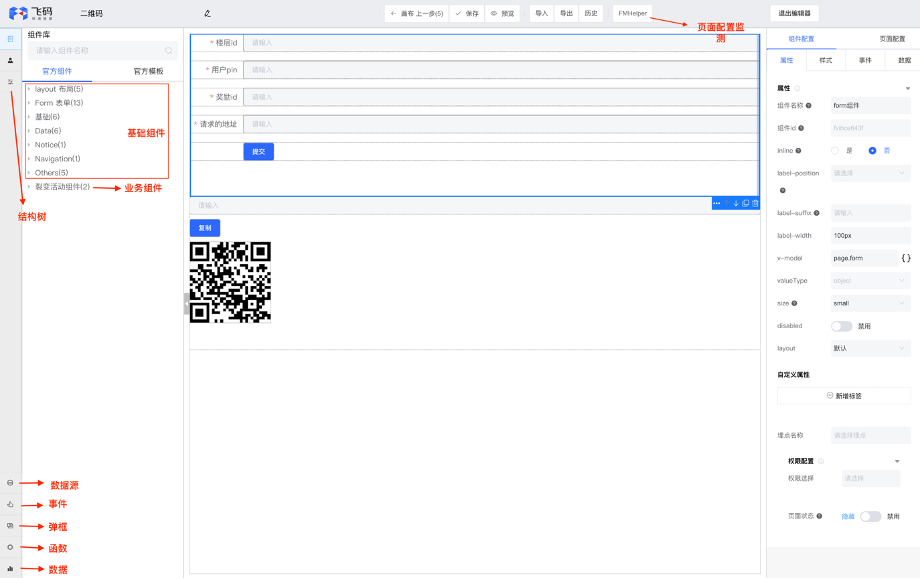这篇文章主要介绍“Fuse.js模糊查询算法怎么使用”,在日常操作中,相信很多人在Fuse.js模糊查询算法怎么使用问题上存在疑惑,小编查阅了各式资料,整理出简单好用的操作方法,希望对大家解答”Fuse.js模糊查询算法怎么使用”的疑惑有所帮助!接下来,请跟着小编一起来学习吧!
Fuse.js是什么
最近在项目里用到了Fuse.js做模糊查询,便对这个算法起了点好奇心,翻了翻源码。
Fuse.js 是一个 JavaScript 库,用于执行模糊字符串搜索。它通过比较搜索字符串与目标字符串的相似度来找到最佳匹配。
Fuse.js 使用一种称为 Bitap 算法的搜索算法来找到最佳匹配。Bitap 算法是一种用于字符串搜索的二进制算法,它通过比较二进制位来判断字符串是否匹配,其中模式可以与目标有所不同。该算法采用位向量数据结构和按位比较以实现字符串匹配。
核心算法Bitap
Bitap算法是fuse.js中用于实现模糊搜索的核心算法之一,其主要思路是利用位运算来计算模式串和目标串之间的相似度。具体来说,Bitap算法首先将模式串转换为二进制掩码,并利用位运算来计算模式串和目标串之间的相似度,然后采用一些启发式策略来提高算法的准确性和效率。
在fuse.js中,Bitap算法的实现主要在
BitapSearch1. 构造函数初始化
在构造函数中,会根据配置参数计算并设置一些内部变量,如模式串的二进制掩码、距离阈值等。
const addChunk = (pattern, startIndex) => {
this.chunks.push({
pattern,
alphabet: createPatternAlphabet(pattern),
startIndex
})
}createPatternAlphabetmaskexport default function createPatternAlphabet(pattern) {
let mask = {}
for (let i = 0, len = pattern.length; i < len; i += 1) {
const char = pattern.charAt(i)
mask[char] = (mask[char] || 0) | (1 << (len - i - 1))
}
return mask
}|||<<1 << (len - i - 1)1len-i-1len=4i=21(4-2-1)1000000102以模式字符串
"hello"mask{
"h": 16, // 二进制00010000,表示 "h" 在模式字符串的第一个位置
"e": 8, // 00001000,第二个位置
"l": 3, // 00000011,第三和第四个位置
"o": 1 // 00000001,第五个位置
}2. 类暴露的searchIn方法
2.1 参数和工具函数
searchIn方法中,调用了search函数。可以看到,search函数接收了
textpatternopionsconst { isMatch, score, indices } = search(text, pattern, alphabet, {
location: location + startIndex,
distance,
threshold,
findAllMatches,
minMatchCharLength,
includeMatches,
ignoreLocation
})fuse.js提供了这些参数的默认值,比如其中的FuzzyOptions:
export const FuzzyOptions = {
location: 0,
threshold: 0.6,
distance: 100
}我们重点关注
threshold[0, 1]thresholddistance具体来说,对于一个长度为
mdm * (1 - threshold)threshold0.64d = 4 * (1 - 0.6) = 1.6141computeScoreexport default function computeScore(
pattern,
{
errors = 0,
currentLocation = 0,
expectedLocation = 0,
distance = Config.distance,
ignoreLocation = Config.ignoreLocation
} = {}
) {
const accuracy = errors / pattern.length
if (ignoreLocation) {
return accuracy
}
const proximity = Math.abs(expectedLocation - currentLocation)
if (!distance) {
// Dodge divide by zero error.
return proximity ? 1.0 : accuracy
}
return accuracy + proximity / distance
}accuracy = 错误数/模式长度proximity = 期望位置 - 当前匹配位置distancescore = accuracy + proximity / distance我们得到了匹配得分,现在让我们回到search函数。
2.2 第一次循环:
whiletextpatterncomputeScorelet index
// Get all exact matches, here for speed up
while ((index = text.indexOf(pattern, bestLocation)) > -1) {
let score = computeScore(pattern, {
currentLocation: index,
expectedLocation,
distance,
ignoreLocation
})
currentThreshold = Math.min(score, currentThreshold)
bestLocation = index + patternLen
if (computeMatches) {
let i = 0
while (i < patternLen) {
matchMask[index + i] = 1
i += 1
}
}
}currentThresholdcomputeMatchestruematchMask2.3 第二次循环
每次开始搜索前,重置几个变量如
bestLocationbinMaxmaskpatternLenbestLocation = -1
let lastBitArr = []
let finalScore = 1
let binMax = patternLen + textLen
const mask = 1 << (patternLen - 1)用一个for循环遍历给定的搜索模式中的每个字符,计算出搜索模式的每个字符对应的掩码值,这个掩码用来进行位运算匹配。
for (let i = 0; i < patternLen; i += 1){
//...不急不急,后面一步步来分解。
}二分查找算法更新区间端点
我们先看这个循环体内的一个
whilecomputeScorelet binMin = 0
let binMid = binMax
while (binMin < binMid) {
const score = computeScore(pattern, {
errors: i,
currentLocation: expectedLocation + binMid,
expectedLocation,
distance,
ignoreLocation
})
if (score <= currentThreshold) {
binMin = binMid
} else {
binMax = binMid
}
binMid = Math.floor((binMax - binMin) / 2 + binMin)
}在这个循环中,每次计算二分区间中间位置的得分,然后根据当前得分和阈值来更新区间端点。这样,循环会不断缩小搜索范围,直到找到最佳匹配或者搜索范围缩小到为空为止。再用这个值赋值给
binMax// Use the result from this iteration as the maximum for the next.
binMax = binMid计算区间两端的值
计算出左端点 start 和右端点 finish:
let start = Math.max(1, expectedLocation - binMid + 1)
let finish = findAllMatches
? textLen
: Math.min(expectedLocation + binMid, textLen) + patternLen
// Initialize the bit array
let bitArr = Array(finish + 2)
bitArr[finish + 1] = (1 << i) - 1左端点
startexpectedLocation - binMid + 111finishfindAllMatchestextLenfindAllMatchesfinishtextLenfinishexpectedLocation + binMidtextLenpatternLen初始化二进制数组
bitArrfinish + 2bitArrfinish + 1(1 << i) - 1i10遍历区间
从右往左遍历文本中的每个字符。这个循环体的代码很长,没关系,继续分解便是。
for (let j = finish; j >= start; j -= 1) {
let currentLocation = j - 1
let charMatch = patternAlphabet[text.charAt(currentLocation)]
if (computeMatches) {
// Speed up: quick bool to int conversion (i.e, `charMatch ? 1 : 0`)
matchMask[currentLocation] = +!!charMatch
}
// First pass: exact match
bitArr[j] = ((bitArr[j + 1] << 1) | 1) & charMatch
// Subsequent passes: fuzzy match
if (i) {
bitArr[j] |=
((lastBitArr[j + 1] | lastBitArr[j]) << 1) | 1 | lastBitArr[j + 1]
}
if (bitArr[j] & mask) {
finalScore = computeScore(pattern, {
errors: i,
currentLocation,
expectedLocation,
distance,
ignoreLocation
})
// This match will almost certainly be better than any existing match.
// But check anyway.
if (finalScore <= currentThreshold) {
// Indeed it is
currentThreshold = finalScore
bestLocation = currentLocation
// Already passed `loc`, downhill from here on in.
if (bestLocation <= expectedLocation) {
break
}
// When passing `bestLocation`, don't exceed our current distance from `expectedLocation`.
start = Math.max(1, 2 * expectedLocation - bestLocation)
}
}
}先看第一段:
let currentLocation = j - 1
let charMatch = patternAlphabet[text.charAt(currentLocation)]
if (computeMatches) {
// Speed up: quick bool to int conversion (i.e, `charMatch ? 1 : 0`)
matchMask[currentLocation] = +!!charMatch
}
// First pass: exact match
bitArr[j] = ((bitArr[j + 1] << 1) | 1) & charMatch这里 根据该字符是否与模式串中的对应字符匹配,更新 bitArr 数组相应位置的值。
patternAlphabet[text.charAt(currentLocation)]charMatch(bitArr[j + 1] << 1 | 1)& charMatch这里需要注意的是,由于 bitArr 数组的长度比文本串和模式串的长度都要长 2,因此 bitArr 数组中最后两个位置的值都为 0,即 bitArr[finish + 1] 和 bitArr[finish + 2] 的值都为 0。
// Subsequent passes: fuzzy match
if (i) {
bitArr[j] |=
((lastBitArr[j + 1] | lastBitArr[j]) << 1) | 1 | lastBitArr[j + 1]
}这段代码实现了模糊匹配的逻辑。
lastBitArrbitArr在第一次匹配只考虑完全匹配,
bitArr[j]bitArr[j+1]lastBitArrjlastBitArr[j+1]bitArr[j]接下来,判断当前位置的匹配结果是否满足阈值要求,如果满足,则更新最优匹配位置。
if (bitArr[j] & mask) {
finalScore = computeScore(pattern, { //...一些参数,这里省略 })
// This match will almost certainly be better than any existing match.
// But check anyway.
if (finalScore <= currentThreshold) {
// Indeed it is
currentThreshold = finalScore
bestLocation = currentLocation
// Already passed `loc`, downhill from here on in.
if (bestLocation <= expectedLocation) {
break
}
// When passing `bestLocation`, don't exceed our current distance from `expectedLocation`.
start = Math.max(1, 2 * expectedLocation - bestLocation)
}
}如果
bitArr[j] & maskfinalScorefinalScorecurrentThresholdbestLocation如果最优匹配位置
bestLocationexpectedLocationstart????????判断当前错误距离是否已经超出了之前最好的匹配结果,如果已经超出,则终止后续匹配,因为后续匹配的结果不可能更优。
// No hope for a (better) match at greater error levels.
const score = computeScore(pattern, {
errors: i + 1,
currentLocation: expectedLocation,
expectedLocation,
distance,
ignoreLocation
})
if (score > currentThreshold) {
break
}
lastBitArr = bitArr最后,真的最后了????????:
const result = {
isMatch: bestLocation >= 0,
// Count exact matches (those with a score of 0) to be "almost" exact
score: Math.max(0.001, finalScore)
}
if (computeMatches) {
const indices = convertMaskToIndices(matchMask, minMatchCharLength)
if (!indices.length) {
result.isMatch = false
} else if (includeMatches) {
result.indices = indices
}
}convertMaskToIndices()接下来,回到searchIn函数,我们会看到对result结果的一些其它处理。这里不再赘述。
基于动态规划算法的Levenshtein算法
动态规划(Dynamic Programming)常用于处理具有有重叠子问题和最优子结构性质的问题,它将原问题分解成一系列子问题,通过求解子问题的最优解来推算出原问题的最优解。动态规划算法两个关键步骤:设计状态转移方程,用来表示状态之间的关系;确定边界,设置循环结束条件。
一个经典的动态规划算法例子,使用动态规划算法实现斐波那契数列:
function fibonacci(n) {
if (n === 0 || n === 1) return n;
const dp = new Array(n + 1).fill(0);
dp[0] = 0;
dp[1] = 1;
for (let i = 2; i <= n; i++) {
dp[i] = dp[i - 1] + dp[i - 2];
}
return dp[n];
}Levenshtein算法是一种用于计算两个字符串之间的编辑距离的算法,即需要将一个字符串转换为另一个字符串所需的最少编辑次数。编辑操作可以是插入、删除或替换字符。
function levenshteinDistance(str1, str2) {
const m = str1.length;
const n = str2.length;
const dp = [];
for (let i = 0; i <= m; i++) {
dp[i] = [i];
}
for (let j = 1; j <= n; j++) {
dp[0][j] = j;
}
for (let i = 1; i <= m; i++) {
for (let j = 1; j <= n; j++) {
const cost = str1[i-1] === str2[j-1] ? 0 : 1;
dp[i][j] = Math.min(
dp[i-1][j] + 1,//删除
dp[i][j-1] + 1,
dp[i-1][j-1] + cost
);
}
}
return dp[m][n];
}让我们照着下图来分析如何求出
dp[i][j]| | | s | i | t | t | i | n | g |
| | 0 | 1 | 2 | 3 | 4 | 5 | 6 | 7 |
| k | 1 | 1 | 2 | 3 | 4 | 5 | 6 | 7 |
| i | 2 | 2 | 1 | 2 | 3 | 4 | 5 | 6 |
| t | 3 | 3 | 2 | 1 | 2 | 3 | 4 | 5 |
| t | 4 | 4 | 3 | 2 | 1 | 2 | 3 | 4 |
| e | 5 | 5 | 4 | 3 | 2 | 2 | 3 | 4 |
| n | 6 | 6 | 5 | 4 | 3 | 3 | 2 | 3 |假设我们要将字符串
str1str2dpdp[i][j]str1istr2j为了求出
dp[i][j]str1istr2j-
删除字符串
中的第str1
个字符,然后将剩余的字符转换为字符串i
的前str2
个字符。这种情况下,j
就等于dp[i][j]
,其中dp[i-1][j] + 1
表示将字符串dp[i-1][j]
的前str1
个字符转换为字符串i-1
的前str2
个字符所需的最少编辑次数,再加上删除字符的操作次数 1。j -
在字符串
的第str1
个位置插入字符i
,然后将剩余的字符转换为字符串str2[j]
的前str2
个字符。这种情况下,j
就等于dp[i][j]
,其中dp[i][j-1] + 1
表示将字符串dp[i][j-1]
的前str1
个字符转换为字符串i
的前str2
个字符所需的最少编辑次数,再加上插入字符的操作次数 1。j-1 -
将字符串
中的第str1
个字符替换为字符i
,然后将剩余的字符转换为字符串str2[j]
的前str2
个字符。这种情况下,j
就等于dp[i][j]
,其中dp[i-1][j-1] + cost
表示将字符串dp[i-1][j-1]
的前str1
个字符转换为字符串i-1
的前str2
个字符所需的最少编辑次数,再加上替换字符的操作次数 cost(如果j-1
和str1[i]
相同,那么str2[j]
就为 0,否则cost
就为 1)。cost
上述三种操作中所需的最少编辑次数取最小值,便可作为将字符串
str1istr2j







